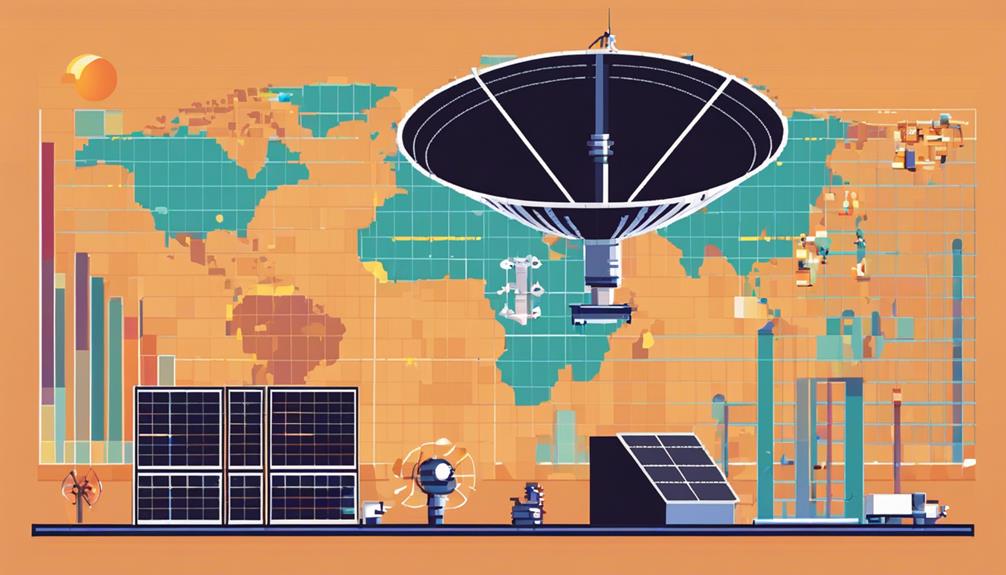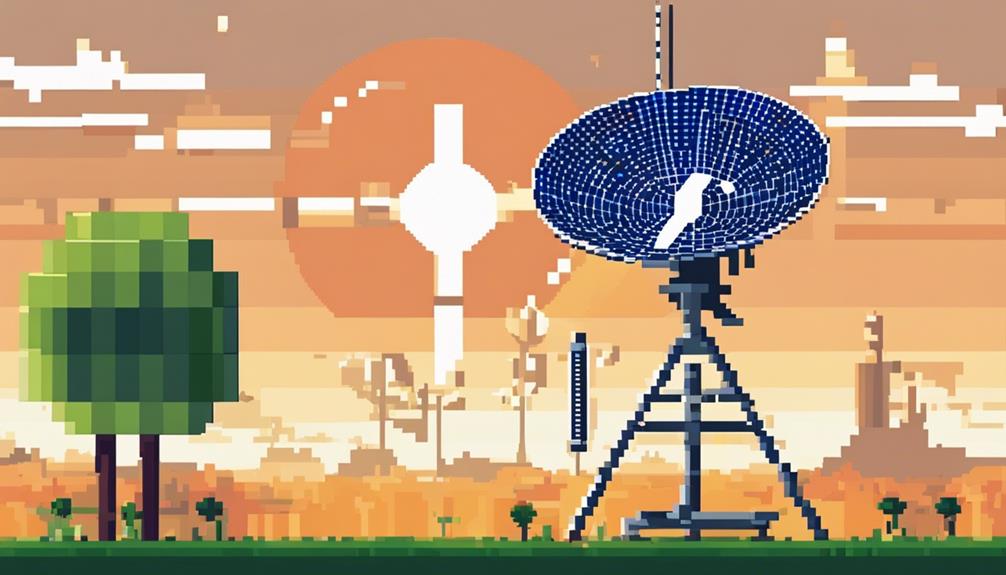Satellite internet has revolutionized global connectivity, yet its environmental repercussions are intricate and consequential. The energy-intensive nature of satellite operations, predominantly fueled by non-renewable sources, raises concerns about greenhouse gas emissions and climate impact. Moreover, the proliferation of space debris from satellite launches poses risks to operational satellites and environmental sustainability. Amidst these challenges, the quest for sustainable satellite technology and responsible operational practices beckons, prompting a crucial dialogue on the delicate balance between technological advancement and environmental preservation in the satellite internet era.
Key Takeaways
- Satellite internet technology raises concerns about resource consumption and space debris management.
- Energy consumption in satellite operations contributes to a significant carbon footprint.
- Light pollution from satellites disrupts ecosystems and astronomical observations.
- Sustainable practices like responsible disposal and debris tracking are vital for satellite internet sustainability.
Environmental Concerns

Raising significant environmental concerns, satellite internet technology prompts discussions regarding resource consumption, light pollution, and space debris management. The environmental impact of satellite internet encompasses various facets, with energy consumption being a primary concern. The operation of satellites requires a substantial amount of energy, leading to a notable carbon footprint. As more satellites are launched into orbit to support satellite internet services, the collective energy consumption continues to rise, exacerbating the environmental impact.
In addition to energy consumption, the proliferation of satellites contributes to space debris risks. With an increasing number of satellites in orbit, the potential for collisions and the creation of space debris grows significantly. This poses risks not only to existing satellites but also to future space missions and activities. Efforts to mitigate space debris risks are crucial to ensuring the sustainability of satellite internet technology.
Moreover, light pollution concerns are another aspect of the environmental impact of satellite internet. The deployment of numerous satellites in low Earth orbit can result in light pollution, affecting astronomical observations and disrupting ecosystems that rely on natural light cycles. Addressing light pollution concerns is essential to minimize the environmental impact of satellite internet and preserve the integrity of the night sky. In conclusion, comprehensive strategies are needed to address these environmental concerns effectively and sustainably manage the impact of satellite internet technology.
Space Debris Impact
The management of space debris is a critical concern due to the escalating risks posed to operational satellites and future space missions. Debris tracking systems play a pivotal role in monitoring and assessing the movement of space debris to mitigate collision risks. Furthermore, initiatives for space debris cleanup are essential to maintain the sustainability and safety of satellite communication systems.
Debris Tracking Systems
Efficient debris tracking systems play a critical role in monitoring and preventing potential collisions between operational satellites and space debris.
Key Points:
- Debris tracking systems monitor over 23,000 objects in space larger than a softball to prevent collisions with satellites.
- These systems use radar and telescopes to track space debris, including defunct satellites, rocket stages, and fragments from past missions.
- Active monitoring is crucial to protect operational satellites from potential collisions with debris traveling at high speeds.
- Space agencies collaborate on data sharing and collision avoidance maneuvers to safeguard satellites and the International Space Station.
Collision Risk Mitigation
Given the escalating number of satellite launches and the consequent rise in collision risks, implementing effective collision risk mitigation strategies is paramount in safeguarding satellite operations and space infrastructure. The accumulation of space debris due to increased satellite launches poses significant threats to operational satellites and the sustainability of space activities. Responsible satellite disposal practices play a crucial role in managing space debris and reducing collision risks. Operators must prioritize the development and adherence to protocols for the safe disposal of defunct satellites to mitigate long-term sustainability risks. Addressing the challenge of space debris impact mitigation is essential for ensuring the safety and longevity of satellite operations, emphasizing the importance of sustainability in the management of space activities.
Space Debris Cleanup
Amidst the escalating risks posed by space debris to operational satellites and critical space infrastructure, the imperative for comprehensive space debris cleanup initiatives becomes increasingly apparent. Space debris cleanup is crucial for ensuring the long-term sustainability of satellite internet operations and environmental impact mitigation. To address this challenge effectively, operators must prioritize responsible disposal practices and proactive debris removal efforts. The management of defunct satellites and other debris is essential to safeguard active satellites from potential collisions, thereby upholding the stability and functionality of satellite systems in orbit. By investing in space debris cleanup endeavors, the space industry can mitigate collision risks, enhance satellite safety, and uphold the integrity of space operations for future generations.
Light Pollution Effects
Satellite constellations emitting bright artificial light significantly impact the environment through light pollution, posing challenges to astronomical observation and nocturnal ecosystems. The artificial light from satellites adds to the overall light pollution, diminishing the visibility of stars and celestial bodies in the night sky. This interference is particularly detrimental to stargazing activities and astronomical research, as it reduces the clarity and contrast of astronomical observations.
Moreover, the disruption caused by excessive light from satellite constellations extends beyond the realm of astronomy. The altered lighting conditions can have adverse effects on nocturnal wildlife behavior and their habitats. Many species rely on natural darkness to carry out essential activities such as foraging, reproduction, and navigation. The presence of artificial light at night can interfere with these behaviors, leading to disruptions in ecosystems and potentially endangering certain wildlife populations.
To address these issues, satellite providers must prioritize the development of technologies aimed at minimizing light pollution from their constellations. Strategies such as reducing the brightness of satellites, implementing light shielding measures, and optimizing satellite positioning can help mitigate the environmental impacts of satellite-induced light pollution. By taking proactive steps to limit the disruption caused by artificial light, satellite operators can contribute to the preservation of natural nightscapes and the well-being of nocturnal ecosystems and wildlife.
Energy Consumption Analysis

Analyzing the energy consumption of satellite internet systems reveals a substantial environmental impact, particularly in comparison to traditional broadband services. Here are some key points to consider:
- High Energy Demand: Operating satellite services require a significant amount of energy, with consumption levels approximately four times higher than those of traditional broadband services. This heightened energy demand contributes significantly to the environmental footprint of satellite internet systems.
- Fossil Fuel Reliance: Ground stations that facilitate satellite signals predominantly rely on fossil fuels for their operation. This reliance exacerbates environmental concerns, as the burning of fossil fuels contributes to carbon emissions and air pollution.
- Renewable Energy Solutions: Transitioning to renewable energy sources such as solar and wind power presents a viable solution to reduce the carbon footprint associated with satellite internet systems. By harnessing clean energy alternatives, the environmental impact of satellite operations can be mitigated.
- Atmospheric Impact: Solar panels installed on satellites play a crucial role in converting solar energy into radio waves for communication. However, this process can impact the atmosphere and Earth's surface, underlining the intricate relationship between energy consumption in satellite systems and its broader environmental repercussions.
The energy consumption of satellite internet systems not only influences operational efficiency but also poses significant environmental challenges, necessitating a shift towards sustainable energy practices to minimize adverse effects on the planet.
Ground Infrastructure Challenges
The establishment and expansion of ground infrastructure for satellite internet systems present notable challenges in terms of ecological impact and sustainability. Ground infrastructure, including satellite dish installations and data centers, can disrupt local ecosystems through habitat disturbance and fragmentation. Clearing land for these facilities poses challenges for biodiversity conservation, emphasizing the need for responsible site selection and construction practices to minimize ecological impacts.
| Challenges | Description |
|---|---|
| Habitat Disturbance | Ground infrastructure projects can lead to the destruction of habitats, affecting local wildlife. |
| Energy Consumption | Satellite ground stations require significant energy, often sourced from fossil fuels. |
| Ecological Footprint | Minimizing the ecological footprint of ground infrastructure is crucial for sustainability. |
Addressing these challenges is crucial to ensure the sustainable operation of satellite internet systems. Efforts to minimize habitat disturbance, reduce energy consumption, and lower the ecological footprint of ground infrastructure are essential steps in mitigating the environmental impact of satellite internet. By implementing environmentally conscious practices and technologies, the adverse effects of ground infrastructure on ecosystems can be lessened, promoting a more sustainable approach to satellite internet operations.
Sustainable Satellite Design Solutions

Investing in efficient solar panels for satellite power generation and implementing measures to reduce space debris are key aspects of sustainable satellite design solutions. By optimizing solar panel efficiency, satellites can generate more power with less surface area, leading to reduced energy consumption and lower environmental impact. Additionally, mitigating space debris through responsible satellite design practices is crucial for maintaining the long-term sustainability of satellite operations in orbit.
Efficient Solar Panels
Utilizing advanced solar panel technology is essential for enhancing the sustainability of satellite internet systems and reducing their reliance on fossil fuels.
- Efficient Energy Conversion: Solar panels efficiently convert solar energy into electricity to power satellite internet systems.
- Reduced Fossil Fuel Dependence: By harnessing solar power, satellite operations can decrease their reliance on fossil fuels, thus lessening their environmental impact.
- Sustainable Operations: Solar panels enable satellite internet systems to operate more sustainably and efficiently, aligning with environmental conservation goals.
- Long-Term Sustainability: Investing in advanced solar panel technology not only benefits the environment by reducing carbon emissions but also ensures the long-term sustainability of satellite communication.
Reduced Space Debris
Implementing sustainable satellite design solutions to reduce space debris is crucial for enhancing the long-term viability of satellite internet systems. Sustainable satellite design focuses on efficient de-orbiting strategies to prevent the accumulation of space debris. By integrating technologies such as propulsion systems and drag sails, satellites can be safely removed from orbit at the end of their operational life. This proactive approach helps in avoiding the creation of long-lasting debris that could pose risks to other satellites. Responsible end-of-life disposal is a priority in sustainable satellite designs, ensuring that satellites re-enter the Earth's atmosphere safely or move to a graveyard orbit. Adhering to guidelines for safe and controlled satellite disposal significantly contributes to mitigating the environmental impact of satellite internet operations.
Light Mitigation Strategies
To minimize light pollution and reduce the impact of satellite constellations on the environment, light mitigation strategies focus on decreasing the brightness of satellites through various techniques. These strategies include:
- Dark Coating Implementation: Applying dark coating on satellite surfaces can significantly reduce the reflection of sunlight, thereby decreasing light pollution caused by satellite constellations. By absorbing more light rather than reflecting it, dark-coated satellites appear dimmer from the ground, mitigating their impact.
- Satellite Orientation Optimization: Satellites can be strategically oriented to minimize their visibility from the ground, especially during critical astronomical observation times. By adjusting their positioning, satellites can reduce the interference with astronomical observations and help protect the dark sky environment for astronomers.
- Adaptive Brightness Technology: Innovations in satellite technology enable the adjustment of brightness levels based on the satellite's position in orbit. This adaptive capability allows satellites to regulate their luminosity, ensuring that they are not excessively bright when passing over sensitive areas, thus actively contributing to light pollution mitigation efforts.
- Collaborative Approach: Collaboration between satellite internet providers and the astronomical community is essential for developing and implementing effective light mitigation strategies. By working together, stakeholders can address concerns related to light pollution and find sustainable solutions that balance the benefits of satellite internet with environmental preservation.
Renewable Energy Integration

Renewable energy integration within satellite internet systems presents a promising avenue for sustainable operations. Solar power offers benefits such as reliability and scalability, while wind energy solutions can enhance cost-effectiveness. However, challenges related to grid connection and intermittency require careful consideration for successful implementation in satellite internet infrastructure.
Solar Power Benefits
The integration of solar power within satellite internet systems demonstrates a tangible reduction in carbon emissions and environmental impact, showcasing a move towards greater sustainability and eco-friendliness.
Solar Power Benefits:
- Solar power integration reduces carbon emissions significantly.
- Utilizing solar energy enhances the sustainability of satellite operations.
- Research indicates that solar panels on satellites improve energy efficiency and decrease reliance on fossil fuels.
- Renewable energy sources like solar power offer cost-effective and efficient solutions for powering satellite communication systems.
Solar power not only aligns with the goal of minimizing the carbon footprint of satellite internet services but also presents a promising avenue for a more environmentally conscious approach to satellite operations.
Wind Energy Solutions
Wind energy solutions integrated into satellite internet systems offer a substantial opportunity for cost savings and enhanced environmental sustainability through their demonstrated ability to significantly reduce operating costs and carbon emissions. Studies have shown that wind turbines can reduce operating costs in satellite internet systems by up to 30%. The integration of wind energy in satellite internet operations not only helps in reducing emissions but also promotes sustainability by lowering the carbon footprint of satellite communication. Research indicates that wind energy solutions offer both cost and efficiency benefits in powering satellite internet systems, aiding in decreasing the environmental impact of energy consumption.
| Benefits of Wind Energy Solutions in Satellite Internet Systems | |||
|---|---|---|---|
| Cost Savings | Emissions Reduction | Sustainability Promotion | Efficiency Improvement |
| Lower operating costs | Reduced carbon emissions | Environmental footprint reduction | Enhanced system performance |
Grid Connection Challenges
Integrating renewable energy sources such as solar and wind power into satellite internet systems poses significant challenges related to grid connections.
Key Points:
- Efficient grid connections are essential for reliable power supply in satellite operations.
- Feasibility and effectiveness of renewable energy integration in satellite communication are impacted by grid connection challenges.
- Stable grid connections play a vital role in maximizing the sustainability benefits of incorporating renewable energy into satellite internet infrastructure.
- Overcoming grid connection obstacles is crucial for reducing the carbon footprint of satellite internet systems through the adoption of renewable energy.
Environmental Impact Assessments Importance

Ensuring the comprehensive assessment of environmental impacts is paramount in the evaluation of satellite internet installations. Environmental impact assessments play a crucial role in identifying potential risks associated with the deployment of satellite internet technologies. These assessments delve into the ecological consequences such installations may have on wildlife habitats, ecosystems, and air quality. Factors such as energy consumption, space debris generation, and light pollution from satellite constellations are carefully considered during these evaluations.
Balancing Connectivity and Sustainability
Achieving a harmonious equilibrium between global connectivity demands and environmental sustainability poses a critical challenge in the realm of satellite internet infrastructure. Satellite technology, while expanding global connectivity, also brings forth significant environmental implications, primarily through its carbon footprint and energy consumption. To address this delicate balance, several key considerations must be taken into account:
- Carbon Footprint: Satellite internet systems have been shown to have a larger carbon footprint compared to traditional internet services. This is primarily due to the substantial energy requirements of satellite operations, including both the satellites themselves and the ground stations that relay signals.
- Energy Consumption: The energy demands of ground stations for satellite signals are considerable and often rely heavily on fossil fuels. This reliance further exacerbates the environmental impact of satellite communication, contributing to issues such as global warming.
- Environmental Impact: Beyond energy consumption, satellite systems can have additional environmental impacts, such as radiation leaks that may contribute to global warming and disrupt animal behaviors. These impacts necessitate a comprehensive approach to sustainability in satellite technology.
- Sustainability Initiatives: Steps towards achieving a balance between connectivity and sustainability include investing in energy-efficient satellite designs and utilizing environmentally friendly materials in satellite construction. Furthermore, businesses must play a crucial role in promoting responsible and ethical usage of satellite technologies to minimize their environmental footprint.
Future of Satellite Internet Sustainability

To propel the sustainability of satellite internet into the future, strategic investments in energy-efficient satellite designs and environmentally conscious production methodologies are imperative. Companies such as SpaceX and OneWeb are leading the way by exploring greener technologies to minimize the environmental impact of satellite communication systems. Advocacy for systemic change and embracing environmental consciousness in business decisions are critical for ensuring the future sustainability of satellite communication.
Future Sustainability Strategies:
| Initiatives | Description | Impact |
|---|---|---|
| Energy-efficient Satellite Designs | Research and development into satellites that consume less power and operate more efficiently. | Reduces carbon footprint of satellites, decreases energy consumption. |
| Environmentally Friendly Production | Implementing eco-friendly manufacturing processes, such as using sustainable materials and reducing waste. | Lowers environmental impact of satellite production, promotes sustainability. |
| Renewable Energy Offsetting | Offsetting carbon emissions by utilizing renewable energy sources to power satellite facilities. | Mitigates environmental harm, supports renewable energy adoption in the industry. |
Frequently Asked Questions
How Does Satellite Affect the Environment?
Satellite operations impact the environment through high energy consumption, significant E-waste production, and carbon footprint enlargement, leading to climate change and resource depletion. Satellite emissions contribute to environmental degradation and wildlife disturbance, affecting nesting success and animal behaviors. Understanding the intricate link between satellite activities and environmental consequences is crucial for sustainable decision-making. How can we balance technological advancement with environmental preservation to secure a greener future for all?
What Are the Risks of Satellite Internet?
Risk factors associated with satellite internet include e-waste management challenges, high energy consumption for operations, disruption to wildlife due to satellite infrastructure, light pollution affecting nocturnal animals, space debris threatening Earth's orbit, potential radiation exposure from satellite systems, large carbon footprint compared to traditional services, and resource depletion from satellite manufacturing. These risks necessitate careful consideration and mitigation strategies to minimize the environmental impact of satellite internet technologies.
How Does Starlink Affect the Environment?
Energy consumption in satellite internet, like Starlink, is significant, with data centers and ground stations requiring substantial power. This consumption contributes to a high carbon footprint. Satellite deployment, including Starlink's constellations, also poses risks of space debris and disrupts wildlife habitats. E-waste is another concern as satellites have a limited lifespan, adding to environmental impact. These factors underline the complex environmental challenges associated with satellite internet systems.
What Is the Impact of Internet to Environment?
Energy consumption from internet usage impacts the environment through increased carbon emissions, contributing to climate change. The production and disposal of electronic devices results in e-waste, leading to resource depletion and pollution. Internet infrastructure development can cause deforestation and disrupt wildlife habitats. Managing these factors is critical to mitigate the environmental consequences of internet usage, necessitating sustainable practices and technological improvements to reduce its overall impact on the environment.
